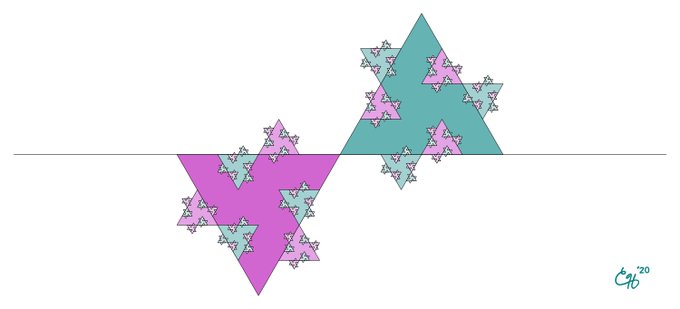
A few weeks ago, we announced a competition to design some fractal bunting, without giving too much of a particular guide as to what we were looking for, in order to spark people’s creativity and get them making (or imagining) some lovely mathematical decorations with which to festoon things. We had a large range of types of entry, and it’s given us some inspiration for how we might (infinitely) brighten up the place.
Since we know much more about fractals than we do about design, we asked illustrator Hana Ayoob to help judge the entries on their aesthetic merit, and here we present some of our favourite entries, along with the announcement of the winner.
We were quite happy for entries to just be a quick doodle illustrating an idea, and Nikki Rohlfing suggested one way to fractal up your bunting would just be to join the tips of the triangles with more, smaller bunting. Probably best suited to a tall room?
We also enjoyed this entry from Mathslover333, who decorated some bunting with Fibonacci spirals:
Some entries got more practical, and actually made the bunting and sent a photo, including this square fractal idea from Katherine Seaton:
Katherine also put together some knitted fractal bunting – although it would have been nice to see it all strung up together:
The Sierpinski triangle, understandably given its triangular connection to normal bunting, was a popular theme; including in this video entry from Andrew Stacey:
Some entries took the fractal theme as a starting point and created something which works as a beautiful decoration on its own, but has a secret fractal aspect – Thessa Kockelhorn’s crocheted rose bunting looks normal, until you realise that each section can be arranged into a larger rose that looks like each of the smaller ones, which could be used to make a theoretical giant rose bunting:





While most traditional bunting has the same fractal dimension all the way along, some of our entries had a different design on each triangle, like Alison’s:
We usually think of bunting as being triangular, but in some sense it’s also just a collection of flags; this entry took the idea of flags and mashed it up with a sort-of-Koch-snowflake idea:
Chris also entered this option, a true fractal, flipping the idea of bunting on its head by having one triangle above and one below the string, then repeating this pattern on each edge of the triangles. This could make some really nice bunting if extended (ideally, infinitely in each direction):

However, all of these paled in comparison to our favourite entry, sent in by serial-fractal-bunting-competition-enterer Katherine Seaton.
Featuring the Fibonacci Snowflake (a fractal we’d never even heard of, based on the Fibonacci Word) and with impeccably neat stitching, lovely colour scheme and mesmerising patterns, Kath’s bunting is our winner.
Katherine, please contact us (email root@aperiodical.com with your postal address) and we’ll send you a copy of Hana’s book, Here Come The Numbers for you to keep, or give to a nearby small person who’s interested in numbers.
